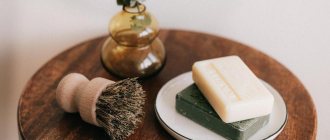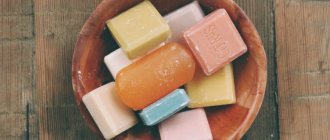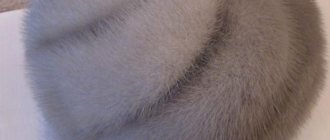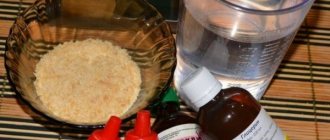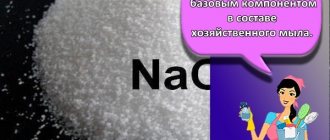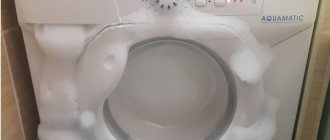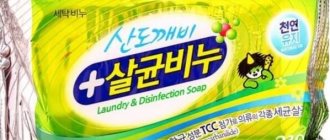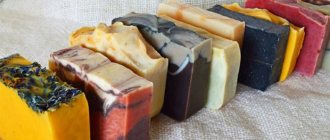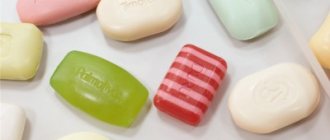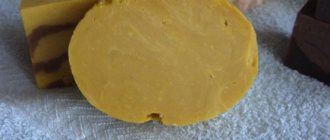Making soap at home is a fun and rewarding activity. This is an individual approach to skin care, an original gift, and a type of income. Handmade soap contains natural ingredients and combines cleansing procedures with skin care.
Beautiful soap can be a wonderful gift
Making soap with your own hands is not difficult, however, as with everything, there are some subtleties. In order to avoid disappointment, a novice soap maker should delve into some of the nuances of the process in advance and study different options for preparing detergent.
Materials for DIY soap making
The first thing a novice soap maker should do is become familiar with the ingredients from which soap is made. The correct selection of ingredients will allow you to produce a quality product. Here is its composition:
- soap base;
- dyes;
- flavors and essential oils;
- additives;
- base oils;
- alcohol;
- forms.
Depending on what kind of soap you want to get, the necessary elements are used. To work, you will need plastic spoons, wooden sticks, and rubber gloves.
Soap bases
Ready-made soap base is a semi-finished product with which you can create exclusive soap without much effort. It contains alkali, vegetable oils and a little water. The factory base cannot be called a 100% natural product, because additives are present in it, but in much smaller quantities than in a store-bought product.
Soap base “DA soap crystal”
The trade offers creamy, white and transparent bases. White has a dense consistency, hardens quickly and mutes the colors. In a transparent base, the colors are vibrant. Creamy is used to produce scrub soap, cream soap, and cake-shaped soap.
When making your own soap, the base can be made from scratch, and it will be a completely natural product. Beginning soap makers can use baby soap instead of the base, but in this case, you must understand, the final product will always be matte.
Dyes
Dyes are divided into 3 types: natural, food, pigments. Natural ones include coffee, sea buckthorn oil, vegetable and fruit juices.
Dyes for making soap
Food dyes do not cloud the base, but are able to migrate - move into adjacent layers. Dry food colorings are concentrated and should be diluted in water beforehand.
Cosmetic pigments come in a huge palette of colors, but they cloud the base. They are liquid and dry. Pearlescent pigments are introduced into the soap and used for exterior decoration.
Flavors
Soap flavoring is carried out using essential oils, fragrances (ready-made flavorings), food flavorings.
Essential oils have a positive effect not only on the skin, but also on the entire body as a whole. However, they should be used with caution - some of them can cause allergic reactions.
Natural essential oils “Marislavna”: red tangerine, tea tree, star anise, rosewood, angustifolia lavender
Essential oils are volatile compounds. In this regard, you need to be prepared for the fact that the aroma will disappear after a few weeks. Sealed packaging will help slow down the process.
High temperatures increase the volatility of oils, so it is advisable to add this type of flavoring to the soap mass at the end of the process.
Cosmetic fragrances delight you with a wealth of choice and give the finished product a lasting aroma. Floral, fruity, compositional, feminine and masculine - everyone will find their own scent.
Flavors (fragrances) for soap with different scents: jasmine, nutmeg, vanilla, etc.
One feature should be taken into account - the presence of a certain percentage of vanilla in the selected aroma is fraught with a change in the color of the finished product. To prevent such a nuisance, a special stabilizer (preservative) is used.
Food flavorings are less persistent than fragrances, but their price is lower.
Supplements
Additives significantly improve the quality of soap. Depending on their type, the product acquires the care direction needed for a particular skin, saturates it with minerals and vitamins, and has a scrub effect. Additives give soap an interesting texture and serve as decoration.
Additives in soap making can vary. The main selection criterion is their usefulness
The list of additives is impressive: chocolate, oatmeal, herbs, vegetable and fruit juices, spices, cocoa, mumiyo, egg yolks, dairy products.
Base oils
It can be sunflower oil, olive oil, sea buckthorn oil or coconut oil. Oil is added to soap to achieve a certain effect - moisturizing, nourishing or softening. The amount per 100 g of base is 1-2 teaspoons.
Base oil for soap
Alcohol
96⁰ alcohol is used to process molds before pouring, adhesion of layers and removal of bubbles that form on the surface of the soap mass.
Glycerol
Glycerin is a substance with pronounced moisturizing and softening properties.
Forms
Molds can be made of wood, plastic or silicone. Wooden ones are durable and have smooth edges. Plastic ones cannot boast of durability, but they will please you with their low price.
Silicone ones are convenient in all respects, varied in shape, but their cost is high. An alternative to them are baking dishes.
Before you begin the soap making process, you need to acquire the necessary equipment, these are:
- Scales accurate to tenths of a gram - for weighing alkali.
- Container for weighing alkali. Disposable cups will do.
- Immersion blender.
- Liquid thermometer.
- Heat-resistant pan for dissolving lye and cooking soap.
- Glass rods and mixing spoon.
- Personal protective equipment: respirator, goggles, rubber gloves.
The equipment must not be used for other purposes.
Silicone soap mold
There are a great variety of compositions for making soap at home, but beginners should start with the simplest ones, without the use of additives.
For skin types
- For oily skin, 3 effects are important: fat absorption, drying and weakening the activity of the sebaceous glands. If fat and acne are associated with seborrhea diagnosed by a dermatologist, specialized sebum-regulating compositions of medicated soap are prescribed. They additionally include anti-inflammatory, antifungal or antibacterial pharmaceutical agents.
- For pigmentation problems, depending on the cause, a scrub or cleansing along with vitamin K and acidic plant juices will help.
- For lipodystrophy (cellulite changes) in the first and second stages, body soaps help, drawing fluid from the deep layers of the skin along with micromassage (contains minerals and sea salt). In the “hard” stage, treatment with cosmetics is impossible, but the lumpy structure is partially compensated by the tightening effect.
- For dry skin , moisturizers containing antioxidants and glycerin are suitable.
- To create a “rejuvenating” effect, soaps with a peeling effect are suitable: with calcium chloride, plant acids and enzymes, vitamin A (to nourish renewed skin and stop excessive sebum synthesis). They remove dying particles and release new layers of epithelium.
When choosing soap with medicinal properties, keep in mind that after taking a bath there should be no feeling of tightness on the skin. It indicates dryness, leading to impaired skin nutrition and hyperactivity of the sebaceous glands.
Individuality is manifested not only in personality traits, but also in the sensitivity of the skin and the composition of the microflora. Therefore, do not be disappointed in the method if the first remedy did not have the same effect as in those who recovered. Do not try to destroy bacterial flora with aggressive detergents. This will make the epithelium vulnerable to dangerous fungal diseases and resistant strains of bacteria that can colonize the free space.
Handmade soap on a ready-made basis: basic recipe
To obtain 100 g of soap you will need:
- base – 100 g;
- oil – 3 tsp;
- fragrance – 3 drops;
- glycerin – 1 tsp;
- dye – 2 drops;
- some water.
Before use, the soap base must be melted. This can be done either in a water bath or in a microwave oven (microwave). First, the base must be crushed - cut into small cubes.
The base should not boil. To avoid this, the substance must be stirred during heating. In the microwave, 100 g dissolve in about 30 seconds. With a larger volume of base, processing is carried out in several stages until complete dissolution.
Algorithm for making handmade soap
- Dissolve the base.
- Heat oil and glycerin in a water bath.
- Combine compositions 1 and 2, add water. The mass should have the consistency of sour cream.
- Add dye and fragrance.
- Pour into molds and spray with alcohol.
- After cooling, remove from the molds and leave to dry for 2 days.
Kinds
Before you figure out what soap is made from, you should find out what it actually is.
Currently this product is divided into:
- Economic
This soap is used when washing clothes and has a solid consistency. It may be scented, but more often it has its own, unique, not particularly pleasant specific odor.
- Dressing
This type of soap has an excellent cleaning effect and foams well even in water of medium hardness at room temperatures. It should have a pleasant smell and color, and also not have an allergic or drying effect on the skin.
- Special
There are several types of such soap, of which the most commonly used is medical soap. It contains various disinfectants and medicinal substances, such as sulfur, tar, ichthyol, etc.
In addition, there are types of soap for various industries that are not used in everyday life.
Homemade soap from scratch
Soap can be made at home in two ways: hot and cold. When cold, the soap ingredients are not boiled, but kneaded. The kneading process is quick, but the ripening period lasts about a month.
With the hot method, the manufacturing process is longer, but you will be able to use the finished product much earlier. This soap rinses out faster than when made using the cold process.
The first step towards an excellent result is drawing up a recipe. The main ingredients are vegetable oils, alkali and liquid - water or herbal decoctions. The composition of oils determines the qualities of soap such as foaming, hardness, and shelf life.
There are two types of alkali used: potassium hydroxide and sodium hydroxide. Sodium alkali is used to produce classic soap, and potassium alkali is used for liquid soap, being the basis for shampoos and scrubs.
The final result in soap making depends on the correct proportions of the main components. Each oil has its own saponification number, which means the amount of alkali needed to turn the oil into soap. This data is stored in soap calculators that can be found on the Internet; their use is simple and straightforward.
Overfat is the amount of oil that does not have enough alkali for the saponification reaction. It will not become soap, but will act as skin care. With the cold method, “extra” oil is placed in the calculator for calculation. The hot method involves adding superfat to the soap mass before placing it in the mold.
What is natural soap made from?
Today, manufacturers offer natural soap in a wide range, but its composition does not always correspond to the description. A truly natural product is made from vegetable oil (coconut, palm, olive), which cares for the skin, making it soft and velvety. It can contain up to 90-100% oil, making it latherable even in salt water. You can make this soap yourself using our recipes as a starting point.
In order not to be disappointed in such an interesting hobby, you should use the recommendations of experienced people.
Handmade soap is a great gift for yourself or loved ones. Try making it yourself to get a healthy and natural cosmetic product at home.
Safety precautions for soap making
Often beginners in soap making are afraid to work with alkali, but without it the saponification reaction will not occur and soap will not work.
When working with alkali, it is necessary to strictly observe safety precautions.
Necessary items for safety precautions when making soap
You will need long sleeves and protective equipment. You must work with an open window or the hood on, without the presence of unauthorized persons. It makes sense to keep an open bottle of vinegar solution on the table to rinse possible places where the alkali comes into contact with skin or clothing.
Brief Industry Analysis
In Russia, liquid soap occupies a large share of the total production volume in the industry (35.9% in 2022)
The market demonstrates positive dynamics every year. Of course, after the 2014 crisis, growth slowed down, but the general trend still persists.
In 2017, 2.5 thousand tons of soap were produced, in 2022 already 3.6 thousand tons. In 2022, the figure is expected to be 3.8 thousand tons.
Toilet soap is generally the most profitable sales segment for private brands. Recently, their products have become more attractive to buyers.
Competition in the market is quite high. There are several large ones, “Spring”. There are also medium and small production facilities, and there is import. And yet the demand is not fully covered - that is, new companies in the industry have every chance to succeed and get their share.
Castile soap from scratch
Due to the small number of ingredients, Castile soap is considered an ideal option for a beginner. Classic recipe for a unique product:
- Extra virgin olive oil – 500 g;
- water – 165 g;
- NAOH – 63.89 g;
- overfat – 5%.
Cold process technology for making Castile soap
- Heat the oil in a water bath.
- Measure out the required amount of water and lye.
- An alkaline solution is prepared by adding small portions of lye to water ( not the other way around! ). The reaction that occurs is accompanied by the release of a significant amount of heat.
- To reduce the temperature, it is advisable to freeze part of the water in advance and place the mixing container in a sink with cold water. If the alkali crystals have not completely dissolved, the solution will have to be filtered through a sieve.
- Mix the oil and alkaline solutions, cooled to the same temperature, with a spoon and then with an immersion blender (a mixer is not suitable!) until a trace is formed. This is the consistency of the mass at which the flowing soap remains on the surface in the form of tubercles. The duration of mixing depends on the composition of the oils; it takes from 2 to 20 minutes.
- Gel stage. The soap laid out in molds should be wrapped in thick cloth and left for several hours in a warm place. This can be an oven preheated to 70⁰C and turned off, or a warm radiator. The gel stage makes the mass transparent, and the maturation period of the soap is reduced by 2 weeks.
- After cooling, remove the soap from the mold and cut into pieces. Allow to ripen for 4 weeks in a cool, ventilated area.
The product does not have an expiration date: the longer it is stored, the better it becomes. It is gentle on the skin, but cleanses perfectly.
Castile soap
Hot process Castile soap
The first 4 points are similar to the actions in the cold method.
- Cover the reduced soap mass with a lid and place in the oven for 3 hours at a temperature of 60⁰C.
- Add superfat and mix, arrange into molds.
- After cooling, cut into pieces.
Soap prepared in this way is ready for use immediately, but it is better to give it a week to dry. The finished product should be stored wrapped in film to avoid overdrying.
What and how is laundry soap made from?
Laundry soap, which is used in everyday life today, was originally intended for personal hygiene due to its antibacterial properties. Classic Soviet soap must contain at least 72% fatty acids, which determines its high cleaning ability. It is the percentage of fatty acids that can be indicated on bars of standard soap. In addition to the number 72%, you can see 64 and 69%, this is how soap of the second and third grade is designated. In addition to fats, the composition contains alkali in an amount of 0.15-0.20%.
Making soap from old scraps is most often the first step in the art of soap making.
Laundry soap is made from vegetable or animal fats with the addition of caustic soda, resulting in an environmentally friendly composition without harmful impurities, fragrances and dyes. In the Soviet Union, factories did not prohibit the use of animal fat to produce soap, but history knows examples when only vegetable oils were used in soap making. For example, in France in the 17th century, a law was passed according to which it was forbidden to use any fats other than olive oil in the production of soap. The result was the famous Marseille soap, which much later became the prototype for laundry soap.
Those who enjoy this procedure later turn this hobby into a serious hobby and even one of the ways to earn a stable income.
In production, laundry soap is made on the basis of fatty acids and alkali. The raw fat is placed in a cauldron and cooked at high temperature (121°C) for 10 days. The result is an adhesive soap, which is treated with an alkali solution. The still hot mixture is poured into molds, where it hardens for another two days.
After final cooling, the soap is cut into pieces and released for sale.
Preparing clear soap
To make clear soap, prepare the following ingredients:
- Coconut oil – 150 g;
- Castor oil – 120 g;
- Glycerin – 210 g;
- Water – 90 g;
- Alkali – 45.7 g;
- Pork fat – 30 g.
Transparent soap
It is prepared like this:
- Add lye to cold water.
- Melt coconut oil along with fat, and then add castor oil.
- When everything has cooled down, add an alkaline solution to the mixture.
- Mix the ingredients until smooth with a blender.
- Place the resulting mass in a water bath, where it simmers for 2 hours, stirring occasionally.
- At the end of 2 hours, add glycerin and continue to simmer until smooth.
- When finished, pour the mixture into molds and leave to harden.
Do not place the molds in the refrigerator or place that is too cold, otherwise it will become cloudy.
A little history
Scientists believe that soap was made in ancient Sumer, and the first surviving recipe for such a product dates back to 2200 BC. e. The Romans improved the methods of producing detergents and began to include a variety of additives and fragrances in their composition. As for the Middle Ages, until the 14th-15th centuries, a piece of fragrant soap was worth its weight in gold; only aristocrats and representatives of the highest clergy could use it. After this, it took another 2 centuries for detergents to be produced on an industrial scale. The real revolution occurred in the 20th century, when the soap formula was supplemented with numerous chemical additives that reduced the cost of its production.
Useful tips for making soap
- Essential oils evaporate quickly and therefore should not be added to a hot base. It's better to wait until it cools down.
- Before adding the dye to the soap, it is better to mix it with the base oil, then the formation of lumps will be avoided.
- You need to mix the ingredients carefully, otherwise bubbles will form.
- Using colored clay instead of dyes: red, yellow, the soap will be not only colorful, but also beneficial for the skin.
- To prevent pieces of fruit, flowers or grass from molding inside the soap, dry them well.
- When using several essential oils when making soap, check their compatibility according to the table.
Essential Oil Compatibility Chart - It is best to cut the soap into bars after cooking in a large mold, using a miter box. Then the pieces will be the same in thickness and width.
- Soap made from several layers looks very beautiful. When making, spray each layer with alcohol.
Technology
The production of soap by the production method is based on the hydrolysis of fats with alkalis, resulting in alcohols and alkali metal salts.
To make it, heated fats are saponified with sodium hydroxide in special digesters. As a result of the reaction in digesters, a homogeneous viscous liquid is formed - soap glue from soap and glycerin, which thickens when cooled. A low-grade product is prepared from it, containing 40-60% fatty acids.
To make sound soap, the glue is treated with electrolytes. As a result of this procedure, the liquid is separated into 2 layers:
- top layer - contains 60 percent or more fatty acids;
- the lower one is soap liquor, with a high content of glycerin and polluting components contained in the feedstock.
As a result of grinding dried kernel soap, a peeled product with an improved structure is obtained, which contains 72-74% fatty acids.
In addition to the above types of soap, solid sodium and liquid potassium soaps are also produced. In the first case, caustic soda is used, and in the second, potassium hydroxide.
Where to get soap ingredients
All the necessary ingredients for making your own soap can be found in specialized stores, but in small towns these are unlikely to be found. Of course, everything can be purchased separately. Dyes are sold in grocery stores, flavorings in perfume shops, and soap base in household stores. Alternatively, instead of the base, you can use baby soap, but in this case you will not be able to get a transparent product.
DIY soap making kit
If it is not possible to buy soap base, it can be purchased in online stores, as well as everything else - fragrances, dyes. It is more practical to order a complete soap making kit. It will contain all the necessary elements to make soap from scratch.
Soap classification
Soaps are classified according to the following criteria.
I. According to the characteristics of reaction with water:
- soluble alkaline – potassium, sodium and ammonium salts of higher carboxylic acids;
- insoluble metal - salts of other metals.
II. According to the state of aggregation:
- liquid – potassium and ammonium salts;
- solid - salts of sodium, lithium and other metals.
III. By area of application:
- household (used for washing things);
- medical (contain disinfectants);
- toiletries (used for washing the body), etc.
Documentation
The first step in opening a soap factory is registering a business activity. You can conduct business as an individual entrepreneur (individual) or LLC (one of the forms of a legal entity). However, in the first case there are restrictions on production volumes and the number of trade transactions. In addition, wholesale and retail chains of non-food products quickly agree on supplies with legal entities.
When registering, indicate OKVED code 24.51 “Production of glycerin, soap; detergents, cleaning agents, polishing agents.”
The production of goods must comply with TR CU 009/2011 “On the safety of perfumery and cosmetic products.” That is, you need to undergo testing and receive a declaration of compliance with technical regulations.
For the production premises, it is necessary to obtain positive conclusions from the Fire Inspectorate and the Sanitary and Epidemiological Station (SES).
What are the dangers of synthetic additives?
Synthetic additives present in store-bought soap significantly reduce its cost, but cause dryness, tightness, irritation and flaking of the skin, as well as various allergic reactions. Important! In some cases, chemical components of hygiene products can provoke diseases such as bronchial asthma, chronic runny nose or eczema. The most dangerous synthetic additives included in regular store-bought soap include: surfactants, solvents, stabilizers, artificial colors, fragrances and fragrances.
Who to sell finished products to?
We sell the resulting products to the target audience. Start implementation with your inner circle - relatives and friends. When you increase the number of types and volume of goods, move to a wider audience.
Soap has different properties, and different categories of customers will need it:
| Property of soap | Main consumers |
| Medicinal | Pharmacies, patient organizations, patients themselves, their friends and relatives |
| Cosmetic (with caring properties) | Beauty salons, women |
| Children's | Pharmacies, stores with children's products, young mothers, grandmothers |
| Decorative | Shops with gift or souvenir assortment, friends and relatives of future birthday people, organizations |
| Hygienic | Shops, hairdressers |
| Economic | Shops, organizations, dacha associations |
It is possible to succeed in producing natural, high-quality handmade soap with proper product positioning. For example, firefly children's soap has little chance of active sales in a souvenir store.
Beginning manufacturers rarely pay attention to the design and name of the product range. Meanwhile, their alignment with the interests of clients increases the chances of success.
Learning how to make natural soap is not difficult - the master will master the nuances in a few days. It is much more difficult to sell finished goods.
Soap production equipment
It is more convenient to produce liquid soap on an automated line equipped with the necessary equipment for the production of a product in a different range.
The line consists of:
- dispenser;
- filter systems;
- mixer and container for mixing ingredients;
- tank for heating soap mass;
- pumps (centrifugal and screw);
- conveyor machine;
- water heater;
- automatic machines for filling and capping containers;
- machines for sticking labels.
This is the basic package. Some equipment models may be equipped with additional options.
On sale there is equipment of Russian and foreign production (Chinese, European). Samples of European technology are of higher quality, but also more expensive.
To save money, you can buy a supported line. But before concluding a deal, you need to clearly determine the condition of the equipment and its level of wear.
Equipment for the production and bottling of liquid soap,
Price RUB 1,470,000 Buy
GOST requirements
Information on how laundry soap is made is presented in State Standard 30266-95.
Product quality requirements according to this document:
- Finished bars must completely decompose into biological components.
- Soap should not be toxic.
- The product must meet all fire safety requirements.
- Finished bars should retain their properties and shape for several years (subject to storage conditions).
- Soap should perform its task when interacting with both cold and hot water.
- Contact with the bar should not provoke the development of an allergic reaction.
According to the regulatory document, laundry soap is distinguished by its purity and environmental friendliness. This is due to the fact that no surrogate substances or preservatives are used in the process of its preparation. The soap making technology meets all modern requirements.
Antibacterial soap
It is a common cleaning agent in hospitals and public facilities. This product is produced in liquid form and is chosen for disinfection and elimination of various bacteria.
Antibacterial soap contains triclosan or triclocarban. These are antimicrobial elements that neutralize the effects of most microorganisms. Note that they kill both harmful and beneficial bacteria.
Triclosan and triclocarban, which are found in antibacterial soaps, leave active residues on surfaces. Therefore, the protective effect of the product lasts for a long time. However, you can easily use regular bar soap in your daily life as it will provide the same protective effect if you wash your hands regularly.
Stage one. Saponification
So, how is laundry soap made? The first step in the actual preparation is mixing the fat and alkali. This directly determines what properties the block will have.
You can see various numbers on it. Many people are interested in what laundry soap is made of 72 percent, 65, etc. Their raw materials are absolutely the same, but the labeling may be different. The percentage of alkali is indicated on the bar. The higher this indicator, the better the properties of the soap. A bar with a figure greater than 70.5% is considered the highest quality. Soap with an alkali content of less than 69% is considered low-grade.
The first stage of manufacturing includes the following items:
- Heating fats. If several types of raw materials are used, they are mixed and melted until they become liquid.
- Alkali dilution. Dry caustic soda is mixed with water. This chemical reaction is accompanied by the release of a large amount of heat. Accordingly, to prevent the liquid from splashing, ice is added to the alkali.
- Mixing the resulting liquids.
This technology is classic. As mentioned above, animal fats can be replaced with other raw materials.
Compound
It can be quite diverse. Before making laundry soap, they decide on its raw materials. This is the first and most important stage of production.
The following can be used as raw materials:
- Vegetable oils (sunflower, palm kernel).
- Animal fats. As a rule, they use pork, beef or lamb. The fat from which laundry soap is made directly affects the technological process. Contrary to popular belief, the bars are not made from raw materials obtained from dogs. This is just a myth. The composition of dog fat is completely unsuitable for making soap.
- Salomas. This is a substance that is obtained by saturating oil with hydrogen atoms. As a rule, nickel acts as a catalyst. The reaction is carried out under the influence of high temperatures (200-300 degrees).
- Fatty acid. The most commonly used are oleic, palmitic and stearic. The release of acids occurs from fats. However, their ratio may be different.
- Synthetic fatty acids. They are made from paraffin. It is heated to 120 °C and blown with air. Manganese compounds are used as a catalyst. Currently, synthetic fatty acids are rarely considered as raw materials. This is due to the fact that the quality of the final product is unsatisfactory.
- Soapstocks. This term refers to products for purifying oils and fats with alkaline solutions. Currently, they are rarely used as raw materials. This is due to the fact that the resulting bars have a distinct unpleasant odor.
The quality of raw materials must meet the conditions of the regulatory document.
Staff
Setting up a small soap factory does not require large staff.
At first, you need a technologist. A soap-making specialist can be outsourced to help set up production and select the appropriate formula (recipe).
In the workshop, 2 people can operate the equipment. One more worker is needed for packaging and storing finished products. Personnel involved in production must have medical records, special clothing and respirators.
The company will require the services of a sales manager and a marketer. One will be involved in searching for sales channels, the second will be involved in advertising, attracting buyers to a new product on the market.
The accountant will take care of all document management matters. You can hire him on a remote basis.
A forwarder will be required to transport raw materials and finished products.
Room
To organize a business you do not need a large premises. An area of 70 square meters is sufficient. m, where there will be a workshop with equipment and a storage room.
In the workshop it is necessary to install communications (good lighting, power supply (380 W), water supply, sewerage, heating), and make a fire protection system. A ventilation system will be required when using aromatic fragrances. The walls of the workshop are covered with ceramic tiles - they wash well and do not accumulate foreign substances or odors.
The mini-factory premises itself should be far from residential areas (no closer than a kilometer). It is better to select a property in an industrial area of the city or in a nearby suburb.
Hard water (without iron and manganese impurities) should not be used in production, therefore it is better to install water purification filters.
For business success, it is vital to organize competent advertising. The market is saturated and competition is high, so customers need to be motivated to buy a product that is new to them.
First, you need to create a brand and develop market attributes for the product. In an oversupplied environment, it is not just products that are sold, but ideas and benefits. Therefore, you need to create an unusual idea, what is special about the new liquid soap, and justify why you need to buy it. The services of a marketer and designer will be required to create a logo, slogan, and corporate identity.
Secondly, you can attract customers through BTL promotions: discounts, gifts, bonuses, presentations at points of sale. You can also distribute flyers and booklets in places with a large flow of people.
And most importantly, liquid soap must be of high quality.
